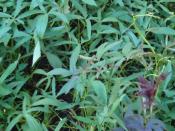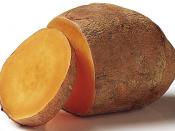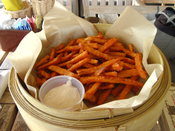I. Problem
Will the kind of food medium affect the rate of reproduction of fruit flies?
II. Hypothesis
The food medium will affect the rate of reproduction of fruit flies. I think that sweet potato will have a more positive affect on the rate of reproduction of the fruit flies. The sweet potato compared to the regular potato has a taste suited by the flies. Fermentation in the sweet potato will most likely give the flies the food medium they need to effectively reproduce. The regular potato will give the fruit flies sufficient food for reproduction but I predict a more successful offspring from the sweet potato medium.
III. Procedure
First, prepare two food mediums of equal amounts and place each in a jar of equal size. Second, put to sleep the culture of fruit flies using ether and the skills learned in class. Segregate the males from the females by the using a hand lens.
Put 5 females and 5 males in each jar. Use a brush in handling the sleeping flies as not to damage their delicate bodies. Cover up the jars with paper and remember to punch holes into it to allow the flies to breathe. Put the jars in a good place away from ants and other insects. Be sure to give the flies sufficient air and sunlight. Observe regularly. As soon as pupa appear, release the adult flies. Wait a few days and count the total number of flies in each jar. Finally, come up with a conclusion for the problem.
Data and Observation:
Day by day observations of both setups:
Day 1: Flies getting use to new environment and surroundings. Most of the time they are at the mouth of the bottle.
Day 2: Horizontal cracks appear in food medium. Flies still adjusting.
Day 3: Cracks disappear.
Day 4: Burrows seen.
Day 5: A few tiny larvae appear on walls of jar
Day 6: More larvae appear. Bigger larvae spotted.
Day 7: Pupae appear. Food medium getting moist.
Day 8: More pupae appear.
Day 9: More larvae appear.
Day 10: Adult flies are released.
Day 11: No change in setup.
Day 12: Pupae hatch.
Day 13: More pupae hatch
Day 14: More pupae hatch.
Day 15: Fruit flies put to sleep and counted.
After 15 days of experimenting, the fruit flies from the potato setup were able to produce 35 offspring. On the other hand, the fruit flies from the sweet potato (kamote) setup were able to produce 328, 9.37 times more than the fruit flies from the potato setup were able to produce.
Discussion
I kept the adult fruit flies as long as I could inside the bottles so that they could lay as many eggs as possible. I felt I should release them on the 10th day because the pupae had been there for 3 days already and could hatch at any moment. I decided to count the offspring on the 15th day because the new flies might start reproducing and form the 3rd generation of flies. My experiment only needs the number of 1st generation offspring. The results of the experiment give us a good picture. The big difference between the two setups tell us what we want to know. However, I am not certain that the food medium was the major factor in the great number of offspring from the kamote setup and a small number from the potato setup. But with the facts gathered from the experiment I can make a conclusion. Like what I said in my hypothesis, I think that the sweet taste of the kamote had some affect on the fruit flies allowing them to produce more offspring. Nutrients found in the sweet potato may also have had a helping hand. A thought that occurred in my mind when thinking what in the kamote made the flies reproduce more was the thought of kamote acting as an to the flies aphrodisiac. The scent of sweet potato during fermentation compared to the sent of plain potato may have stimulated the flies more. Maybe, even the sweet potato itself acted as the aphrodisiac. Of course this was only a thought.
Conclusion
The food medium does affect the rate of reproduction of fruit flies. I was correct in my hypothesis of the problem. Nutrients found in the sweet potato may have made the fruit flies healthier than the flies in the potato setup allowing them to produce an abundant
offspring. Although the exact reason why the sweet potato flies produced more offspring than the potato flies in unknown, I have a number of hypotheses that can explain it. All I know as of this point is that the food medium does affect the rate of reproduction of fruit flies. Sweet potato increases the rate of production by 937% compared to ordinary potato. My conclusion therefore of the experiment is sweet potato acts a better food medium in the event of breeding fruit flies. Potatoes will still allow you to come up with a good number of flies but sweet potatoes will give you a better number.


